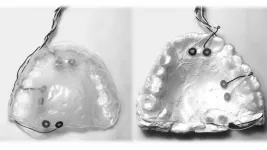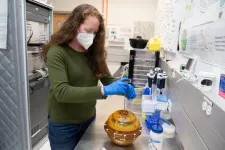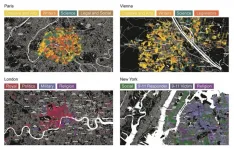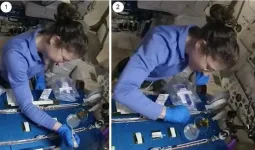Research lays groundwork for restoring lost oral functions with pacemaker-like devices
Researchers determine suitable amplitude for electrically stimulating nerves in the mouth
2021-06-30
(Press-News.org) Even the mundane act of swallowing requires a well-coordinated dance of more than 30 muscles of the mouth. The loss of function of even one of these, due to disease or injury, can be extremely debilitating. For these people, nerve stimulation offers a ray of hope to regain some of their lost oral function.
In a new study, researchers at Texas A&M University have delineated the minimum size of electrical currents needed to provide sensation in different parts of the mouth. The researchers said their study is a first but vital step toward building electrical stimulation implants that can restore essential intraoral functions that are lost due to nerve or brain damage.
The results of the study are published in the journal Institute of Electric and Electronics Engineers' (IEEE) Transactions on Biomedical Engineering.
Many essential bodily functions are coordinated by the nervous system via sensorimotor feedback loops. As the name suggests, these neural circuits involve the brain interpreting incoming signals from sensory nerves and then commanding the motor nerves to execute a certain movement. So, for example, sensorimotor loops play a vital role in voluntary functions, like walking or holding an object, and involuntary movements, like sneezing or blinking.
Within the mouth, also referred to as the intraoral cavity, there is a rich supply of both sensory and motor nerves. In particular, sensorimotor nerves in the soft palate and tongue coordinate several intraoral movements related to swallowing, speech and respiration. And so, damage to either the sensory or motor nerve fibers due to neurotrauma or disease can compromise these essential functions, reducing the quality of life of those afflicted.
Electrical nerve stimulation might help jumpstart the nerves into action, much like how a pacemaker can electrically stimulate nerves in the heart, causing the heart muscle to contract. But unlike a pacemaker, the details on the frequency and amplitude of the electrical currents needed for proper stimulation of different parts of the mouth have not been investigated.
"Electrical stimulation can modulate nerve currents or action potentials, which are the mode of communication to and from the brain," said Dr. Hangue Park, assistant professor in the Department of Electrical and Computer Engineering. "And so, electrical stimulation should be carefully applied, because if not, then it might cause undesirable effects, or it might not stimulate anything at all."
To investigate the minimum stimulation currents needed, Park and his team inserted tiny metal electrodes into a standard dental retainer. These electrodes were positioned in subjects to stimulate either their soft palate or the side and tip of the tongue, which receive a rich supply of sensory nerves. For each of these locations, the researchers slowly changed the amplitude of the stimulation current, keeping the frequency fixed. Then, subjects were asked to report when they just began feeling a sensation and when the sensation was uncomfortable. Next, they repeated the same experiment for a higher frequency of current.
After compiling their data, the team determined the average perception and discomfort thresholds for the tongue and soft palate. In addition, they produced an equivalent circuit of the intraoral cavity to duplicate the electrical properties of that area. This circuit, the researchers said, can help to further study the effects of electrical stimulation offline without requiring human subjects.
The researchers noted that their next steps would be to electrically stimulate the intraoral region and investigate how these simulations change chewing, swallowing and other behaviors.
"Sensorimotor systems can be extremely vulnerable to damage due to neural defects, aging and neurodegenerative diseases," said Park. "In this study, we have begun to lay the groundwork for electrically stimulating parts of the mouth that control involuntary and voluntary movements. Our work is a seminal study and it is important so that we can, in the near future, help people that face enormous challenges doing everyday tasks that we take for granted."
INFORMATION:
Other contributors to this study include Beomhee Park from the electrical and computer engineering department and Dr. Saurabh Biswas, associate professor of practice from the Department of Biomedical Engineering.
This research was funded by the Institute for Rehabilitation and Research Foundation.
[Attachments] See images for this press release:

ELSE PRESS RELEASES FROM THIS DATE:
2021-06-30
Magnetic resonance imaging (MRI) is widely used in medicine to detect, diagnose and treat diseases such as cancer, while relying on experts' interpretation of images. Quantitative MRI, which obtains numerical measurements during the scans, can now potentially offer greater accuracy, repeatability and speed -- but rigorous quality control is needed for it to reach its full potential, according to a new study.
Researchers at the National Institute of Standards and Technology (NIST) led the study by 11 institutions comparing measurements by 27 MRI scanners from three vendors at nine clinical sites around the country. To obtain reference values and disentangle sources of bias and variation, the study used a tissue stand-in, or "phantom," originally ...
2021-06-30
A city's street names can provide a glimpse into its cultural value system and a way to quantify cultural indicators, according to a study published June 30, 2021 in the open-access journal PLOS ONE by Melanie Bancilhon from Washington University in Saint Louis, U.S., and colleagues.
Ever since named streets have existed, they have been used as a form of social engineering, mirroring a town or city's social, cultural, political, and religious values. Building off this concept in what they term "streetonomics," Bancilhon and colleagues used street names as an alternative route to quantify cultural indicators in four influential Western cities: Paris, Vienna, London, and New York.
The authors used multiple open data sources ...
2021-06-30
The deep sea Pacific Salas y Gómez and Nazca ridges are highly biodiverse and host unique fish and invertebrate taxa, according to video surveys.
INFORMATION:
Article Title: Deep-sea biodiversity at the extremes of the Salas y Gómez and Nazca ridges with implications for conservation
Funding: The expeditions were funded by the National Geographic Society and Pristine Seas donors with support to AMF. Conservation International, the Paul M. Angell Family Foundation, Tom and Currie Barron, and Alan Eustace provided additional support to DW, WG and JG. The Chilean Millennium Science Initiative Program grant #NC120030 ...
2021-06-30
In the German population, a surprisingly high 6% of under-18s are at risk of cognitive decline, falls and more from the cumulative effect of anticholinergic medications such as antihistamines and antidepressants.
INFORMATION:
Article Title: Anticholinergic burden: First comprehensive analysis using claims data shows large variation by age and sex
Funding: The authors received no external funding for this work.
Competing Interests: UH, OR, MB and JR are working at an independent, non-profit research institute, the Leibniz Institute for Prevention Research and Epidemiology - BIPS. Unrelated to this study, BIPS occasionally conducts studies financed by the pharmaceutical industry. Almost exclusively, these are post-authorization ...
2021-06-30
Researchers have developed and successfully demonstrated a novel method for studying how cells repair damaged DNA in space. Sarah Stahl-Rommel of Genes in Space and colleagues present the new technique in the open-access journal PLOS ONE on June 30, 2021.
Damage to an organism's DNA can occur during normal biological processes or as a result of environmental causes, such as UV light. In humans and other animals, damaged DNA can lead to cancer. Fortunately, cells have several different natural strategies by which damaged DNA can be repaired. Astronauts traveling outside of Earth's protective atmosphere face increased risk of DNA damage due to the ionizing radiation ...
2021-06-30
An important function of our vision is to segregate relevant figures from the irrelevant background. When we look at a visual stimulus, it drives a cascade of neural activity from low-level to higher level visual brain areas. The higher areas also provide feedback to the lower areas, where figures elicit more activity than the background, as if figures in the brain are highlighted with extra activity. Researchers from the Netherlands Institute of Neuroscience (NIN) now showed that feedback causes the extra neuronal activity in low-level areas and that the extra activity is essential for figure-ground ...
2021-06-30
MIT engineers and researchers in South Korea have developed a sweat-proof "electronic skin" -- a conformable, sensor-embedded sticky patch that monitors a person's health without malfunctioning or peeling away, even when a wearer is perspiring.
The patch is patterned with artificial sweat ducts, similar to pores in human skin, that the researchers etched through the material's ultrathin layers. The pores perforate the patch in a kirigami-like pattern, similar to that of the Japanese paper-cutting art. The design ensures that sweat can escape through the patch, preventing skin irritation and damage to embedded sensors.
The kirigami design also helps the patch conform to human skin as it stretches and bends. This flexibility, paired with ...
2021-06-30
New Brunswick, N.J. (June 30, 2021) - A Rutgers-led team of researchers has developed a microchip that can measure stress hormones in real time from a drop of blood.
The study appears in the journal Science Advances.
Cortisol and other stress hormones regulate many aspects of our physical and mental health, including sleep quality. High levels of cortisol can result in poor sleep, which increases stress that can contribute to panic attacks, heart attacks and other ailments.
Currently, measuring cortisol takes costly and cumbersome laboratory setups, so the Rutgers-led team looked for a way to monitor its natural fluctuations in daily life and provide patients with feedback that allows them to receive the right treatment at the right ...
2021-06-30
A new study based on computational analyses of how SARS-CoV-2 interacts with host cell proteins has identified 200 previously approved drugs that could be repurposed to treat COVID-19, 40 of which have already entered clinical trials. Furthermore, Namshik Han and colleagues identified 30 proteins induced by the SARS-CoV-2 virus that are targeted by 8 or more existing drugs, finding that nitric oxide production, which is important for viral synthesis, may be targeted by these drugs to fight infection. The researchers also identified 2 of these drugs with good safety profiles that successfully reduced viral replication in cellular assays, suggesting they could potentially prevent or treat COVID-19. Scientists now have sufficient ...
2021-06-30
The Bronze Age in the eastern Mediterranean has long been considered by researchers to have been the 'first international age,' especially the period from 1600-1200 BC, when powerful empires from Anatolia, Mesopotamia, and Egypt set up large networks of subordinate client kingdoms in the Near East. These empires fought, traded, and corresponded with one another, and ancient texts from the period reveal rich economic and social networks that enabled the movement of people and goods.
A new study conducted by an interdisciplinary team of archaeologists, geneticists, and isotope experts, and published in PLOS ONE, investigated the movement of people in this period at a single regional center, a Bronze Age city-state called Alalakh in present-day southeastern Turkey. Their results indicate ...
LAST 30 PRESS RELEASES:
[Press-News.org] Research lays groundwork for restoring lost oral functions with pacemaker-like devices
Researchers determine suitable amplitude for electrically stimulating nerves in the mouth








